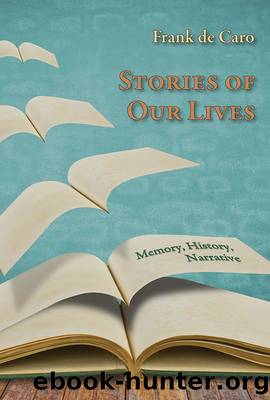Stories of Our Lives by Frank de Caro

Author:Frank de Caro [Caro, Frank de]
Language: eng
Format: epub
Tags: Social Science, General, Folklore & Mythology
ISBN: 9780874218930
Google: D23gCwAAQBAJ
Barnesnoble:
Goodreads: 17134310
Publisher: Utah State University Press
Published: 2013-07-15T00:00:00+00:00
NOTES
1. But Iâm still trying. Madison Smartt Bellâs Charm City: A Walk through Baltimore (New York: Crown Journeys, 2007) was a good read but concerned mostly with his reaction to the cityâs physical layout and hence only somewhat helpful. And I asked Laura Lippman, at her Garden District Books appearance in New Orleans, if she could explain Baltimore. She kindly took a stab at it, to some avail.
2. My old high school and college friend Joseph Skerrett, who went to Hopkins the year after I did, tells this story: Elliott Coleman was also the translator for the Belgian critic and theoretician Georges Poulet. Poulet came to speak and a Hopkins professor of history asked him a question. When Poulet seemed to misunderstand, the historian asked again in perfect French. Hopkins was that kind of place.
3. The Wikipedia entry on the neighborhood gives credit to ânewcomers and real estate brokers,â noting that by the mid-1960s the media had adopted the name. âEast Village, Manhattan,â Wikipedia, last modified 22 February 2013, http://en.wikipedia.org/wiki/East_Village_Manhattan.
4. Dan Wakefield, New York in the 50s (New York: St. Martinâs Griffin, 1999), 275.
5. Wakefield; Bob Dylan, Chronicles: Volume 1 (New York: Simon & Schuster, 2004); John Tytell, Reading New York (New York: Knopf, 2003); Robert Stone, Prime Green: Remembering the Sixties (New York: Harper Perennial, 2008); Suze Rotolo, A Freewheelinâ Time: A Memoir of Greenwich Village in the Sixties (New York: Broadway Books, 2008). Although Stone spent time in New York, he was in California as well as elsewhere, and he concentrates less on New York than the other writers. Rotolo was romantically involved with Dylan, and much of her memoir concentrates on that relationship and upon various other individuals she knew; she has a lot to say about the world of revivalist folk singers, which she observed partly because of her connection with Dylan.
6. Dylan, Chronicles, 103, 72, 22.
7. Probably I did not invent these but am indeed thinking about the cover photo for Dylanâs second album, The Freewheelinâ Bob Dylan, which Rotolo discusses in A Freewheelinâ Time (214ff); her book includes additional photos taken on the same occasion on Jones Street. She notes that Dylan grabbed a suede jacket for the photo shoot quickly and that âIt was an âimageâ choice because that jacket was not remotely suited for the weather ⦠he was bound to freeze going out in thatâ (215). I suppose that the image made a big impression on me. Rotolo also recalls that âit was one of those damp New York City winter days that chill to the boneâ (214).
8. Dylan, Chronicles, 54.
9. Tytell, Reading New York, 301.
10. Which Rotolo writes about in A Freewheelinâ Time (349, 342â44); she suggests that the blackout was âcontrolled chaos.â She also writes (361) how, as time went on, New York seemed to be âgetting grittier and more dangerous ⦠The counterculture was imploding; chaos lurked along the edges,â and suggests being âmired in Vietnamâ as a root cause.
11. Wakefield, New York in the 50s, 1.
12. Ibid., 158.
Download
This site does not store any files on its server. We only index and link to content provided by other sites. Please contact the content providers to delete copyright contents if any and email us, we'll remove relevant links or contents immediately.
Cecilia; Or, Memoirs of an Heiress — Volume 1 by Fanny Burney(32374)
Cecilia; Or, Memoirs of an Heiress — Volume 3 by Fanny Burney(31749)
Cecilia; Or, Memoirs of an Heiress — Volume 2 by Fanny Burney(31714)
The Great Music City by Andrea Baker(31086)
We're Going to Need More Wine by Gabrielle Union(18905)
All the Missing Girls by Megan Miranda(15391)
Pimp by Iceberg Slim(14211)
Bombshells: Glamour Girls of a Lifetime by Sullivan Steve(13927)
Talking to Strangers by Malcolm Gladwell(13131)
Norse Mythology by Gaiman Neil(13125)
Fifty Shades Freed by E L James(13120)
For the Love of Europe by Rick Steves(12341)
Crazy Rich Asians by Kevin Kwan(9123)
Mindhunter: Inside the FBI's Elite Serial Crime Unit by John E. Douglas & Mark Olshaker(9103)
The Lost Art of Listening by Michael P. Nichols(7359)
Enlightenment Now: The Case for Reason, Science, Humanism, and Progress by Steven Pinker(7083)
The Four Agreements by Don Miguel Ruiz(6541)
Bad Blood by John Carreyrou(6476)
Weapons of Math Destruction by Cathy O'Neil(6084)
